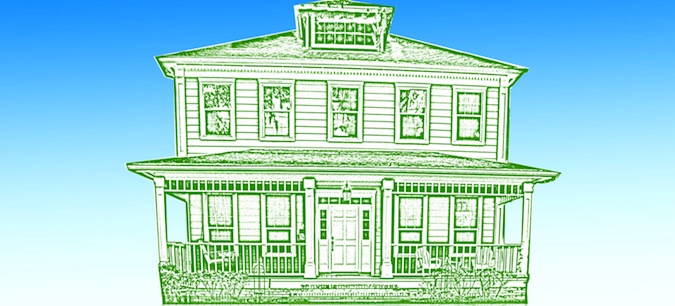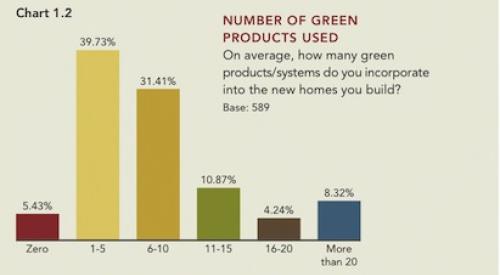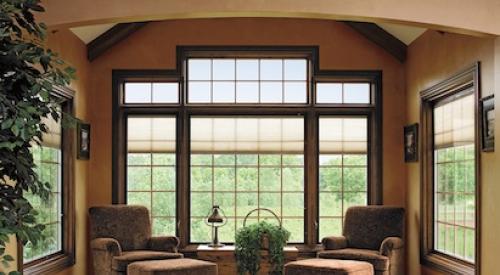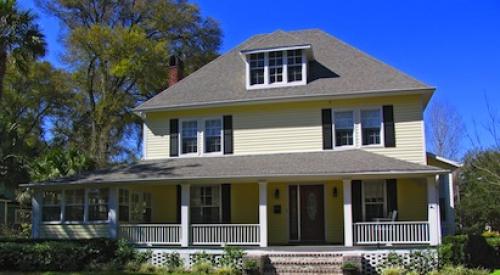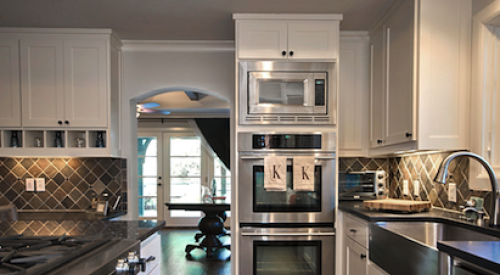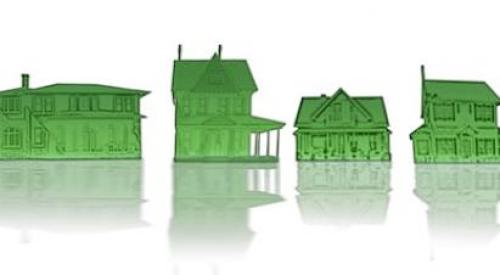While the home-building industry has been slow to adopt green, high-performance design and construction practices, the majority of builders believe green features have intrinsic value when it comes to closing sales on new homes. Sixty-three percent of builders surveyed by Professional Builder in December said they agreed that green helps sell homes (15 percent “strongly agree”; 48 percent “somewhat agree”), and just 9 percent said they disagreed with the notion that green helps close sales.
Moreover, an overwhelming majority of respondents (81 percent) said environmental goals are more important when planning a new residential development today versus five years ago. Only 1 percent said environmental goals were less important today versus five years ago.
Still, despite this resounding recognition of green's marketing advantages, only a small minority of builders are actually building certified-green homes. Just 27 percent of survey respondents said homes built by their firm in 2009 were certified as green or high-performance through a self-certified or third-party program. Even more surprising is the fact that only about a third of builders (39 percent) surveyed provide prospective buyers with a checklist of the energy/sustainable benefits their homes offer — a marketing tactic that doesn't cost a dime.
So, why the disconnect? There are a host of reasons, according to survey respondents. First and foremost, the decimated housing market is dominated by buyers shopping strictly on a lowest-cost basis — a trend that doesn't bode well for builders who are incorporating costly green features in their homes.
“In this market, dollar per square foot is the main qualifier for buyers,” said a builder who has built two green-certified homes. “Most buyers are not willing to invest in additional green benefits, even when we can demonstrate that the cost of ownership will go down and resale value will be higher, and point out the comfort and health aspects.”
Another builder's sentiment: “We compete in a tough market where buyers measure cost and bedroom count to a competitive price. We select green products over others if the cost is the same or close, but some of the technology is just out of reach due to higher first cost and long return on investment.”
The typical first-cost premium for going green can range anywhere from 1 percent to more than 6 percent, according to respondents. About half (44 percent) cited a 3-5 percent premium for green, while only 5 percent said the first-cost premium was negligible.
How much more are buyers willing to spend to go green? Up to 2 percent more, according to a majority of builders surveyed. But a quarter of respondents said their clients won't drop an extra dime for green features.
“The only components of green building that people are willing to pay for are the ones that will save them money on energy bills,” said a Minnesota-based builder. “Our state energy code already gives them an Energy Star rating. Very few buyers are willing to spend money on anything else associated with green.”
Another factor cited by respondents is the lack of understanding and recognition among buyers of the benefits of sustainable, high-performance features (other than energy efficiency).
“Even with education, customers think that all builders build the same way and use the same products,” said a builder who specializes in energy-efficient homes. “We are constantly being compared to builders that build to code minimums.”
Of the green-certification programs available to home builders, Energy Star is far and away the most popular among respondents. Forty-seven percent of builders surveyed that built certified-green homes in 2009 used the Energy Star program, followed by 21 percent for the company's internal program, 12 percent for a local HBA program and 10 percent for the NAHB Green Guidelines. Only 6 percent of homes were certified using the U.S. Green Building Council's LEED for Homes program. The added cost for attaining LEED certification is a huge barrier for most home builders, according to respondents.
“The certification process with LEED is expensive, time-consuming and not realistic, especially for builders doing one custom home at a time,” said a custom-home builder. “The LEED process adds significantly to the cost of the home, especially homes in the lower price ranges.”
When it comes to implementing specific green features and technologies, survey respondents are hottest on measures related to the building envelope and energy efficiency. Nearly three-quarters of respondents (72 percent) said all the homes built by their firm in the past year include energy-efficient windows, and more than half said all homes feature energy-efficient appliances and HVAC systems, along with air-sealing packages to reduce infiltration.
Other popular measures include enhanced insulation; water-saving plumbing fixtures and fittings; moisture-management products and methods; improved indoor air ventilation; energy-efficient lighting; and construction-waste reduction.
| 1 | 2 | 3 | |
| Consumers not willing to pay a premium | 35.4% | 29.2% | 14.4% |
| Adds significantly to first costs | 27.2% | 23.1% | 12.8% |
| Lack of consumer demand | 12.6% | 13.2% | 18.1% |
| Insufficient return on investment | 9.7% | 15.4% | 21.5% |
| Availability of green materials/systems | 3.9% | 6.1% | 6.5% |
| Reliability of vendors | 3.9% | 4.3% | 8.1% |
| Too complicated | 3.0% | 5.5% | 9.1% |
| Performance of green materials/systems | 2.6% | 3.35% | 7.7% |
| Base: 494 Source: Professional Builder Annual Green Building Survey, December 2009 | |||
| All | Most | Some | None | Not Sure | |
| Energy-efficient windows | 72.44% | 16.49% | 5.85% | 4.80% | 0.42% |
| Energy-efficient appliances | 55.11% | 25.47% | 12.32% | 4.80% | 2.30% |
| Air-sealing package to reduce infiltration | 53.03% | 14.82% | 16.08% | 14.82% | 1.25% |
| High-efficiency HVAC system | 53.03% | 22.34% | 16.49% | 6.89% | 1.25% |
| Enhanced insulation | 49.69% | 22.76% | 16.28% | 10.44% | 0.84% |
| Water-saving plumbing fixtures and fittings | 48.23% | 22.96% | 17.54% | 8.98% | 2.30% |
| Moisture-management products and methods | 45.51% | 21.29% | 13.78% | 16.91% | 2.51% |
| Improved indoor air ventilation | 33.82% | 19.62% | 23.59% | 20.88% | 2.09% |
| Energy-efficient lighting | 33.40% | 24.43% | 25.26% | 15.03% | 1.88% |
| Construction waste reduction | 30.90% | 19.62% | 22.96% | 24.01% | 2.51% |
| Low- or no-VOC paints/sealants | 30.48% | 16.91% | 25.05% | 23.17% | 4.38% |
| Ultra-low-flow toilets | 24.43% | 18.79% | 24.63% | 30.27% | 1.88% |
| Advanced framing techniques, pre-assembled components and/or value-engineering methods | 24.22% | 17.75% | 27.35% | 28.81% | 1.88% |
| Products with low off-gassing of indoor pollutants such as formaldehyde-free cabinetry | 21.92% | 14.61% | 28.18% | 26.72% | 8.56% |
| Super-low-flow shower heads | 21.09% | 15.45% | 25.05% | 34.66% | 3.76% |
| Landscape designed with drought-tolerant plants and minimal site/soil disturbance | 14.82% | 14.82% | 23.80% | 41.13% | 5.43% |
| Tankless water heaters | 10.02% | 13.15% | 34.24% | 39.87% | 2.71% |
| Rainwater harvesting system | 5.01% | 2.30% | 11.90% | 77.24% | 3.55% |
| Geothermal heating/cooling systems | 3.34% | 5.22% | 17.95% | 70.77% | 2.71% |
| Photovoltaics/solar panels | 2.51% | 2.30% | 13.78% | 78.29% | 3.13% |
| Graywater reuse system | 0.84% | 2.09% | 8.14% | 84.34% | 4.59% |
| Base: 479 Source: Professional Builder Annual Green Building Survey, December 2009 | |||||
|
